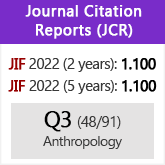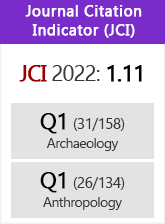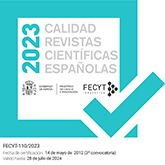Archaeometry and craft context of the gold disks from Fortios (Portalegre, Alto Alentejo, Portugal)
DOI:
https://doi.org/10.3989/tp.2016.12179Keywords:
Archaeometallurgy, Gold, Technology, SEMEDS, Iberia, Bronze Age, Iron AgeAbstract
Starting from the topographic study and the elemental analysis of four gold objects from Fortios, we define a little-known type of gold object and survey all examples known to date. It is important to select the appropriate analytical technique depending on the problem to be solved and in order to obtain reliable results. In our particular case this allowed us to detect a brazing procedure using a solder of a lower melting point than the parts to be joined. Comparing analytical data from other, similar objects permitted the reconstruction of their technological domain, which is clearly Mediterranean. Finally the archaeological context, between the 8th and 7th centuries BC, and the particular character of the workshop point to a craft production belonging to the Orientalizing period of Southwestern Iberia.
Downloads
References
Aballe, M.; Adeva, P. y Perea, A. 1991: "SEM-EDS Microanalytical study of pre- roman gold objects". En W. H. Waldren, J. A. Ensenyat y R. C. Kennard (eds.): II Deià Conference of Prehistory. Recent developments in Western Mediterranean Prehistory: archaeological techniques, technology and theory. British Archaeological Reports Int. Series 573, Tempus Reparatum. Oxford: 239-266.
Alves, L. C.; Breese, M. B. H.; Alves, E.; Paúl, A.; da Silva, M. R.; da Silva, M. F. y Soares, J. C. 2000: "Micron-scale analysis of SiC/SiCf composites using the new Lisbon nuclear microprobe". Nuclear Instruments and Methods in Physics Research B 161-163: 334-338. https://doi.org/10.1016/S0168-583X(99)00768-5
Aranda Jiménez, G.; Montón-Subías, S. y Sánchez Romero, M. 2015: The Archaeology of Bronze Age Iberia. Argaric Societies. Routledge. Londres.
Armbruster, B. y Parreira, R. (eds.) 1993: Inventário do Museu Nacional de Arqueologia, 1. Do Calcolítico à Idade do Ferro. Instituto Português de Museus. Lisboa. Bandera Romero, M. L. de la, y Ferrer Albelda, E. (eds.) 2010: El Carambolo, 50 a-os de un tesoro. Universidad de Sevilla. Sevilla.
Berrocal-Rangel, L. y Silva A.C. 2010: O Castro dos Ratinhos (Barragem do Alqueva, Moura). O Arqueólogo Português, supl. 6. Lisboa.
Bleed, P. 2008: "Skill matters". Journal of Archaeological Method and Theory 15: 154- 166. https://doi.org/10.1007/s10816-007-9046-0
Bonnefoy, Y. (ed.) 1998: Diccionario de las Mitologías, IV Las mitologías de Europa. Destino. Barcelona. Cahill M. 2015: "Here comes the sun". Archaeology Ireland, Spring: 26-33.
Costin, C. 1991: "Craft specialization: issues in defining, documenting and explaining the organization of production". Journal of Archaeological Method and Theory 3: 1-56.
Costin, C. y Hagstrum, M. B. 1995: "Standardization, labor investment, skill, and the organization of ceramic production in late Prehispanic Highland Peru". American Antiquity 60(4): 619-639. https://doi.org/10.2307/282046
Eogan, G. 1994: The accomplished Art. Gold and goldworking in Britain and Ireland during the Bronze Age (c. 2300-650 BC). Oxbow Monograph 42. Oxford.
Escacena Carrasco, J. L.; Fernández Flores, A. y Rodríguez Azogue, A. 2007: "Sobre El Carambolo: un híppos sagrado del Santuario IV y su contexto arqueológico". Archivo Español de Arqueología 80: 5-28. https://doi.org/10.3989/aespa.2007.v80.25
Fernández Flores, A. y Rodríguez Azogue, A. 2005: "El complejo monumetal del Carambolo Alto, Camas (Sevilla). Un santuario orientalizante en la paleodesembocadura del Guadalquivir". Trabajos de Prehistoria 62 (1): 111-138. https://doi.org/10.3989/tp.2005.v62.i1.58
Fernández Flores, A. y Rodríguez Azogue, A. 2007: Tartessos desvelado. La colonización fenicia del suroeste peninsular y el origen y ocaso de Tartessos. Editorial Almuzara. Córdoba.
Ferreira, O.V. 1974: "Notícia da descoberta de jóias auríferas no distrito de Portalegre". Estudos Italianos em Portugal 37: 79-82.
Guérin, S. y Armbruster, B. 2015: "Le disque en or des dépôts de Ribécourt- Dreslincourt (Oise)". Bulletin de la Société Préhistorique Française 112(1): 148-151.
Hartmann, A. 1982: Prähistorische Goldfunde aus Europa II. Studien zu den Anfängen der Metallurgie 5, Axel Hartmann. Berlin.
Heleno, M. 1935: "Jóias pré-romanas". Ethnos 1: 229- 257.
Hernández, M. S. y Soler, J. A. 2005 (eds.): El Tesoro de Villena. Un descubrimiento de José María Soler. Catálogo Exposición, Museo Arqueológico de Alicante. Diputación de Alicante.
Hunt-Ortíz, M.; Ontalba, M.A.; Ortega Feliu, I.; Gómez Tubío, B.; Respaldiza, M. A.; Fernández Flores, A. y Rodríguez Azogue, A. 2010: "Los elementos de oro prehistóricos y protohistóricos de las últimas campa-as de excavación (2002-2006) en el yacimiento de El Carambolo (Camas, Sevilla)". En M. L. de la Bandera Romero y E. Ferrer Albelda (eds.): El Carambolo, 50 a-os de un tesoro. Universidad de Sevilla. Sevilla: 335-344.
Jensen, J.; Jockenhövel, A.; Mohen, J.P.; Éluère, C.; Demakopoulou, K. y Athanassopoulou, S. 1999: L'Europe au temps d'Ulysse. Dieux et héros de l'Âge du Bronze (Catalogue de la 25e Exposition d'Art du Conseil d'Europe Copenhague, Bonn, Paris, Atenas 1998-2000). Réunion des Musées Nationaux. Paris.
Jimeno, A.; Torre, I. de la y Chaín, A. 2010: "Ritos funerarios y mitos astrales en las necrópolis celtibéricas del Alto Duero". En F. Burillo Mozota (ed.): Ritos y mitos. VI Simposio sobre los Celtíberos (Daroca 2008): 369-390. Zaragoza
LIMC 1981-2009: Lexicon Iconographicum Mythologiae Classicae. Artemis Verlag. Düsseldorf.
Maluquer de Motes, J. 1992 : Excavaciones de El Carambolo, Sevilla. Notas y experiencias personales, 1958. Edición facsímil. Diputación Provincial de Huelva. Huelva.
Nicolini, G. 1990: Techniques des ors antiques. La bijouterie ibérique du VIIe au IVe siècle. Picard. Paris. Perea, A. 1991: Orfebrería Prerromana. Arqueología del Oro. Caja de Madrid. Comunidad de Madrid. Madrid.
Perea, A. 2004: "The first millenium BC. Technological domain systems in the Iberian Peninsula: gold workshops and production". En A. Lehörff (ed.): L'artisanat métallurgique dans les sociétés anciennes en Méditerranée occidentale. Collection de l'École française de Rome 332, École française de Rome. Roma: 33-43.
Perea, A. 2010: "Factor tecnómico para el estudio de la producción y consumo de oro en sociedades premonetales: la estandarización". En P. Bueno, A. Gilman, C. Martín Morales y F. J. Sánchez-Palencia (eds.): Arqueología, Sociedad, Territorio y Paisaje. Estudios sobre Prehistoria reciente, protohistoria y transición al mundo romano en Homenaje a M. Dolores Fernández Posse. Bibliotheca Praehistorica Hispana XXVIII, CSIC. Madrid: 25-33.
Perea, A. y Armbruster, B. 1998: "Cambio tecnológico y contacto entre Atlántico y Mediterráneo: el depósito de El Carambolo, Sevilla". Trabajos de Prehistoria, 55 (1): 121-138. https://doi.org/10.3989/tp.1998.v55.i1.320
Perea, A. y Armbruster, B. 2008: "Tradición, cambio y ruptura generacional. La producción orfebre de la fachada atlántica durante la transición Bronce- Hierro de la Península Ibérica". En S. Celestino, N. Rafel y X.L. Armada (eds.): Contacto cultural entre el Mediterráneo y el Atlántico (siglos XII-VIII ane): la precolonización a debate. Escuela Española de Historia y Arqueología en Roma, Serie Arqueológica 11, CSIC. Madrid: 497-508.
Perea, A. y Armbruster, B. 2011: "Tomb 100 at Cabezo Lucero: new light on goldworking in fourth-century BC Iberia". Antiquity 85: 158-171. https://doi.org/10.1017/S0003598X00067508
Perea, A.; García-Vuelta, O. y Fernández Freire, C. 2010: El Proyecto Au. Estudio arqueométrico de la producción de oro en la Península Ibérica. Bibliotheca Praehistorica Hispana XXVII, CSIC. Madrid.
Perea, A. y Hunt-Ortíz, M. 2009: "New finds from an old treasure: the archaeometric study of new gold objects from the Phoenician sanctuary of El Carambolo (Camas, Seville, Spain)". Archeosciences 33: 159-163. https://doi.org/10.4000/archeosciences.2151
Perea, A.; Montero, I. y García-Vuelta, O. 2004: "Project Au and the Au Repertoire. Aresearch strategy in gold metallurgy". En A. Perea, I. Montero y O. García-Vuelta (eds.): Tecnología del oro antiguo: Europa y América. Ancient gold technology: America and Europe. Anejos de Archivo Español de Arqueología XXXII, CSIC. Madrid: 139-146.
Perea, A. y Sánchez-Palencia F.J. 1995: Arqueología del Oro Astur. Orfebrería y Minería. Caja de Asturias. Oviedo.
Pingel, V. 1992: Die vorgeschichtlichen Goldfunde der Iberischen Halbinsel. Eine archäologische Untersuchung zur Auswertung der Spektralanalysen. Madrider Forschungen 17. Walter de Gruyter. Berlin. PMCid:PMC1131060
Rodríguez Azogue, A. y Fernández Flores, A. 2005: "El santuario orientalizante del cerro del Carambolo, Camas (Sevilla). Avance de los resultados de la segunda fase de la intervención". En S. Celestino y J. Jiménez (eds.): El Periodo Orientalizante. Anejos de Archivo Español de Arqueología XXXV. Mérida: 863-871.
Silva, A. C. F. 1991: "O tesouro de Baião". Bayam, Dezembro: 42-51.
Silva, A. C. F. 2007: A Cultura Castreja no Noroeste de Portugal. Câmara Municipal de Paços de Ferreira. Paços de Ferreira.
Silva, A. C. y Berrocal-Rangel, L. 2005: "O Castro dos Ratinhos (Moura), povoado do Bronze Final do Guadiana. 1ª campanha de escavações (2004)". Revista Portuguesa de Arqueología 8: 129-176.
Soares, A. M. M.; Valério, P.; Silva, R. J. C.; Alves, L. C. y Araújo, M. F. 2010: "Early Iron Age gold buttons from South-Western Iberian Península. Identification of a gold metallurgical workshop". Trabajos de Prehistoria 67 (2): 501-510. https://doi.org/10.3989/tp.2010.10053
Taylor, J. J. 1980: Bronze Age Goldwork of the British Isles. Cambridge University Press. Cambridge.
ThesCra 2012: Thesaurus Cultus et Rituum Antiquorum VIII, The Paul Getty Museum. Los Angeles.
Valério, P.; Alves, L. C.; Soares, A.M.; Berrocal-Rangel, L.; Silva, A. C. y Araújo, M. F. 2007: "Early Iron Age gold artifacts from Castro dos Ratinhos (Moura, Southern Portugal)". Proceedings of the 2nd International Conference "Archaeometallurgy in Europe" (Aquileia, Italy 2007). Selected Papers: 368-376. Milán.
Vilaça, R.; Armbruster, B.; Perea, A.; Vivas, F. y Freitas, B. 2015: "Um contexto e um lugar para os discos de ouro da Idade do Ferro de Fortios (Portalegre, Alto Alentejo, Portugal)". Conímbriga LIII (2014): 31-79.
Vilaça, R.; Armbruster, B.; Perea, A. (en prensa): "S`habiller pour briller. Le dépôt desdisques en or du premier âge du Fer trouvé à Fortios (Portalegre, Portugal)". Colloque 'Iron Age Gold in Celtic Europe, society, technology and archaeometry' (11-14 de Marzo 2015). Université Toulouse-Jean Jaurès. Toulouse.
Downloads
Published
How to Cite
Issue
Section
License
Copyright (c) 2016 Consejo Superior de Investigaciones Científicas (CSIC)

This work is licensed under a Creative Commons Attribution 4.0 International License.
© CSIC. Manuscripts published in both the printed and online versions of this Journal are the property of Consejo Superior de Investigaciones Científicas, and quoting this source is a requirement for any partial or full reproduction.All contents of this electronic edition, except where otherwise noted, are distributed under a “Creative Commons Attribution 4.0 International” (CC BY 4.0) License. You may read here the basic information and the legal text of the license. The indication of the CC BY 4.0 License must be expressly stated in this way when necessary.
Self-archiving in repositories, personal webpages or similar, of any version other than the published by the Editor, is not allowed.

















